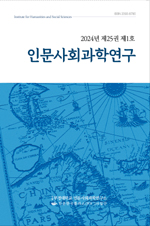- 영문명
- Constructing Moral Judgments through Reflective Equilibrium in Philosophy Education: A Reappraisal of the Role of Intuition
- 발행기관
- 부경대학교 인문사회과학연구소
- 저자명
- 김운용(Woonyong Kim)
- 간행물 정보
- 『인문사회과학연구』제26권 제3호, 1~30쪽, 전체 30쪽
- 주제분류
- 사회과학 > 사회과학일반
- 파일형태
- 발행일자
- 2025.08.31

국문 초록
본 논문은 반성적 평형 이론이 철학교육에서 도덕 판단 구성과 정당화에 어떤 역할을 할 수 있는지를 이론적·실천적으로 분석하고, 특히 그 과정에서 직관의 역할을 비판적으로 재검토한다. 존 롤즈와 노먼 다니엘스의 이론을 바탕으로 하는 반성적 평형은 숙고된 판단, 도덕 원칙, 배경 이론 간의 정합성을 통해 판단을 정당화하려는 절차적 구조로 이해된다. 그러나 피터 싱어와 심리학적 연구들은 반성적 평형이 직관 중심의 구조에 머물 경우, 도덕 이론의 객관적 정당화를 제시하기 어렵다고 비판한다.
이에 대해 본 논문은 게오르그 브룬의 직관에 대한 비추론성 이론을 중심으로 반성적 평형의 정당화 구조를 재구성하고, 다양한 인지적 자원과 이론 간 조정을 통해 판단을 구성하는 가능성을 제시한다. 특히 이러한 이론적 재구성은 철학교육의 실제 수업 장면에서도 판단의 정당화를 위한 절차적 도구로 반성적 평형을 활용할 수 있는 실천적 함의를 지닌다. 마이클 바스케스와 더스틴 웹스터, 그리고 다니엘라 포스터 등의 논의는 반성적 평형이 단지 직관들 간의 정합성을 조정하는 절차에 그치지 않고, 개념적 자원의 도입, 중간 이론의 활용, 대인 관계적 정당화 구조 등을 포괄하는 교육적 방법론으로 확장될 수 있음을 보여준다.
본 논문은 다음과 같은 구성으로 전개된다. 제2장에서는 반성적 평형의 개념과 정당화 구조를 정리하고, 제3장에서는 피터 싱어의 비판을 중심으로 직관 중심 정당화의 한계를 분석한다. 제4장에서는 브룬의 논의를 통해 직관의 비추론성을 중심으로 반성적 평형의 이론적 재구성 가능성을 탐색하며, 제5장에서는 철학교육의 실제 맥락에서 반성적 평형이 어떻게 적용될 수 있는지를 고찰한다. 이를 통해 반성적 평형의 방법이 철학교육에서 판단 구성과 성찰적 사고를 촉진하는 인식론적 도구로 재조명될 수 있음을 보여주는 것이 본 논문의 목적이다.
영문 초록
This paper examines how the theory of reflective equilibrium can serve as a framework for constructing and justifying moral judgments in philosophy education, with a particular focus on re-evaluating the role of intuition in this process. Originally developed by John Rawls and further elaborated by Norman Daniels, reflective equilibrium is understood as a procedural method of justification that seeks coherence among considered judgments, moral principles, and background theories. However, critics such as Peter Singer, along with findings from moral psychology (e.g., Haidt, Greene), argue that the theory relies excessively on intuitions, thereby undermining the possibility of objective moral justification.
In response to these critiques, this study draws on Georg Brun’s argument for the non-essentiality of intuition in reflective equilibrium, proposing a reconstruction of the justificatory structure that emphasizes diverse cognitive resources and the coordination of theoretical commitments. This reconfiguration has practical implications for philosophy education, where reflective equilibrium can be applied as a procedural tool to facilitate students’ critical engagement with the justification of their own judgments. The works of Michael Vazquez, Dustin Webster, and Daniella Forster further demonstrate that reflective equilibrium can evolve beyond a coherence model of intuitions into an educational methodology that incorporates conceptual resources, middle theories, and interpersonal justification structures.
Based on this framework, the paper proceeds as follows: Chapter 2 outlines the concept and justificatory structure of reflective equilibrium. Chapter 3 critically examines Singer’s objection concerning the limits of intuition-centered justification. Chapter 4 explores the theoretical possibility of reconstructing reflective equilibrium by emphasizing the non-essential role of intuition, drawing on Brun’s account. Chapter 5 investigates how reflective equilibrium can be applied in philosophy education through theoretical insights and classroom practices.
목차
Ⅰ. 서론
Ⅱ. 반성적 평형의 개념과 구조
Ⅲ. 피터 싱어의 비판과 직관의 신뢰성 문제
Ⅳ. 반성적 평형의 이론적 기반 재검토: 직관의 비추론성에 대한 탐색
Ⅴ. 철학교육에서 도덕 판단 구성과 반성적 평형의 적용 가능성
Ⅵ. 결론
참고문헌
키워드
해당간행물 수록 논문
참고문헌
최근 이용한 논문
교보eBook 첫 방문을 환영 합니다!

신규가입 혜택 지급이 완료 되었습니다.
바로 사용 가능한 교보e캐시 1,000원 (유효기간 7일)
지금 바로 교보eBook의 다양한 콘텐츠를 이용해 보세요!



